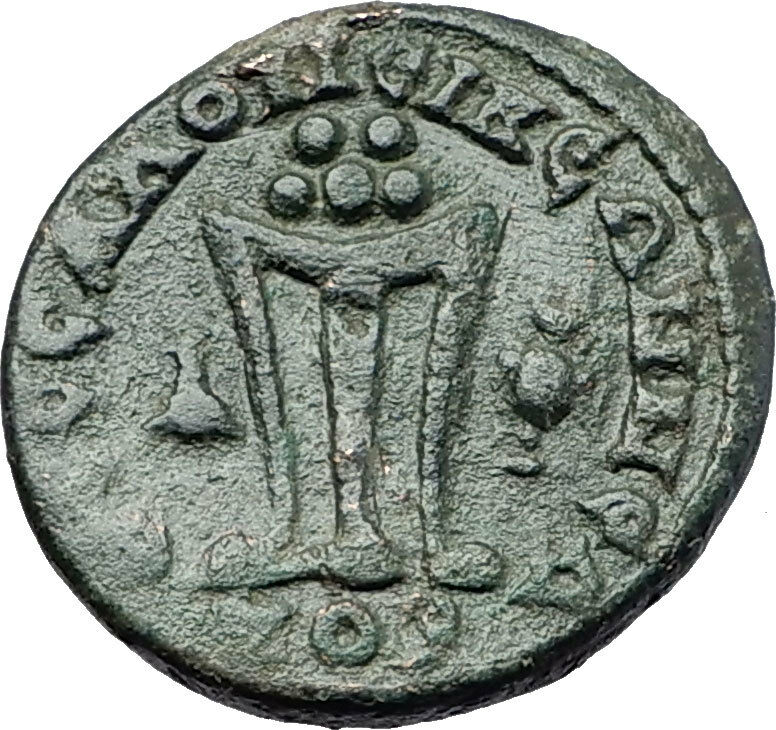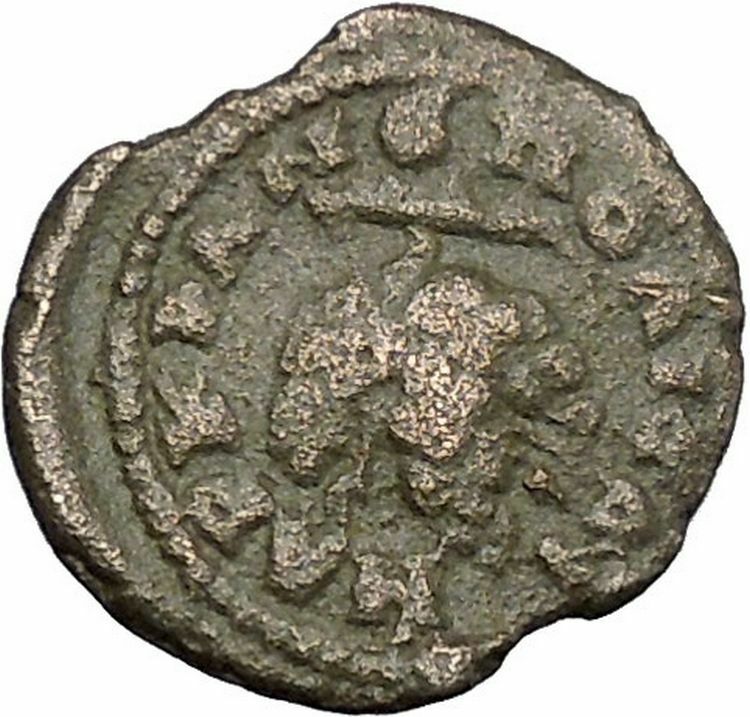|
Trajan
–
Roman Emperor
: 98-117 A.D. –
Bronze Dichalkon 16mm (1.60 grams) of
Alexandria
in
Egypt
Struck Regnal Year 17, 113-114 A.D.
Reference: Milne 710; Emmett 707; K&G 27.574; Dattari (Savio) 7221; Dattari 1100
var.; Köln 643-4;
Laureate head right.
Hem-hem crown of Harpocrates, L IZ (year 17) across fields.
You are bidding on the exact item pictured,
provided with a Certificate of Authenticity and Lifetime Guarantee of
Authenticity.
In late
Greek mythology
as developed in
Ptolemaic Alexandria
, Harpocrates (Ancient Greek:
Ἁρποκράτης) is the
god
of silence. Harpocrates was adapted by the
Greeks
from the
Egyptian child god
Horus
. To the
ancient Egyptians
, Horus represented the
newborn Sun, rising each day at dawn. When the
Greeks
conquered Egypt under
Alexander the Great
, they transformed the
Egyptian Horus into their
Hellenistic
god
known as Harpocrates, a rendering
from Egyptian
Har-pa-khered
or Heru-pa-khered
(meaning “Horus the Child”).
Horus
In Egyptian
mythology
,
Horus
was conceived by
Isis, the mother goddess, from
Osiris
, the original god-king of Egypt, who had
been murdered by his brother
Set
, and thus became the god of the underworld.
The Greeks melded Osiris with their underworld god, Hades, to produce the
essentially Alexandrian
syncretism
,
Serapis
.
Among the Egyptians
the full-grown
Horus
was considered the victorious god of the
Sun who each day overcomes darkness. He is often represented with the head of a
sparrowhawk
, which was sacred to him, as the
hawk flies high above the Earth. Horus fought battles against Set, until he
finally achieved victory and became the ruler of Egypt. All the Pharaohs of
Egypt were seen as reincarnations of the victorious Horus.
Stelae
depicting Heru-pa-Khered standing on the
back of a crocodile and holding snakes in his outstretched hands were erected in
Egyptian temple
courtyards, where they would be
immersed or lustrated in water; the water was then used for blessing and healing
purposes as the name of Heru-pa-Khered was itself attributed with many
protective and healing powers.

Isis, Serapis
and their child Harpocrates
(Louvre
Museum)
In the Alexandrian and Roman renewed vogue for
mystery cults
at the turn of the millennium —
mystery cults had already existed for almost a millennium — the worship of Horus
became widely extended, linked with
Isis (his mother) and
Serapis
(Osiris, his father).

Bronze statuette of Harpocrates,
Begram
,
Afghanistan
, 2nd century.
In this way Harpocrates, the child Horus, personifies the newborn sun each
day, the first strength of the winter sun, and also the image of early
vegetation. Egyptian statues represent the child Horus, pictured as a naked boy
with his finger on his chin with the fingertip just below the lips of his mouth,
a realization of the hieroglyph for “child” that is unrelated to the Greco-Roman
and modern gesture for “silence”. Misunderstanding this sign, the later Greeks
and Roman poets made Harpocrates the god of Silence and Secrecy, taking their
cue from
Marcus Terentius Varro
, who asserted in De
lingua Latina of Caelum (Sky) and Terra (Earth)
“These gods are the same as those who in Egypt are called
Serapis
and
Isis
, though Harpocrates with his finger
makes a sign to me to be quiet. The same first gods were in Latium called
Saturn
and
Ops
.”
Ovid
described Isis:
“Upon her Isis’ brow stood the crescent moon-horns, garlanded with
glittering heads of golden grain, and grace of royal dignity; and at her
side the baying dog
Anubis
, dappled
Apis
, sacred
Bubastis
and the god who holds his finger
to his lips for silence sake.”

Harpocratic Eros, terracotta figurine made in
Myrina
, ca. 100–50 BCE. (Louvre
Museum)
Inexpensive cast terracotta images of Harpocrates, suitable for house
shrines, are found scattered throughout the Roman Empire. Thus
Augustine of Hippo
was aware of the iconic
gesture of Harpocrates:
“And since in practically all the temples where Serapis and Isis were
worshiped there was also a figure that seemed to enjoin silence by a finger
pressed against its lips,
Varro
thinks this had the same meaning,
that no mention should be made of their having been human beings”
Martianus Capella
, author of an allegorizing
textbook that remained a standard through the Middle Ages recognized the image
of the “boy with his finger pressed to his lips” but neglected to mention
Harpocrates’ name: “… quidam redimitus puer ad os compresso digito salutari
silentium commonebat“. The boy was identified, however, as
Cupid
in glosses, a syncresis that had already
resulted in the figure of Harpocratic Cupid (illustration, right).
Plutarch
wrote that Harpocrates was the second
son of Isis and that he was born prematurely with lame legs. Horus the Child
became the special protector of children and their mothers. As he was healed of
a poisonous snake bite by Re
he became a symbol of hope in the gods
looking after suffering humanity.
Another solar cult, not directly connected with Harpocrates, was that of the
Sol
InvictusUnconquered Sun,
.
20th century reference
From the 1920s through the 1950s,
Harpo Marx
performed pantomime and wore either
a curly red or curly blonde wig in character. His brother Groucho jokingly said
he named himself in honour of Harpocrates, as a god of both silence and
childhood, or childish joy. In truth he was named Harpo because he played the
harp.
Modern occultist uses
Modern
occultists
display his image, loosely connected
now with Hermetic
gnosticism
. Typically, “Harpocrates is the Babe
in the Egg of Blue that sits upon the lotus flower in the Nile”. He may be
termed the ‘God of Silence’ and said to represent the Higher Self and be the
‘Holy Guardian Angel’ and more in similar vein, adapted from
Aleister Crowley
‘s often-reprinted Magick.
Many
Discordians
consider
Harpo Marx
to have been a contemporary
avatar
of Harpocrates. Because of this,
Discordians often invoke
Harpocrates as a
Trickster god
or God of Humor in addition to
his classical attribution of God of Silence.
Hemhem crown was an
ancient Egyptian
ceremonial headgear, which was
basically an ornate triple
atef with corkscrew sheep horns and usually two
uraei
. The
Egyptian
word “hemhem” means “to shout”, “cry
out”, possibly indicating that the hemhem crown represented a battle horn.
An early use of the hemhem crown is shown on the golden throne of
Tutankhamun
. Later the hemhem crown was shown
on the images of non-Egyptian rulers, such as
Natakamani
,
Arnekhamani
or
Silko of Nobadia
.
Ptolemy XII Auletes
wearing a
hemhem crown, from the temple of
Kom Ombo
Alexandria was founded
by
Alexander the Great
in April 331 BC as
Ἀλεξάνδρεια (Alexándreia).
Alexander’s
chief architect
for the project was
Dinocrates
. Alexandria was intended to
supersede Naucratis
as a
Hellenistic
center in Egypt, and to be the link
between Greece and the rich
Nile Valley. An Egyptian city,
Rhakotis
, already existed on the shore, and
later gave its name to Alexandria in the
Egyptian language
(Egyptian *Raˁ-Ḳāṭit,
written rˁ-ḳṭy.t, ‘That which is built up’). It continued to exist as the
Egyptian quarter of the city. A few months after the foundation, Alexander left
Egypt and never returned to his city. After Alexander’s departure, his viceroy,
Cleomenes
, continued the expansion. Following a
struggle with the other successors of Alexander, his general
Ptolemy
succeeded in bringing Alexander’s body
to Alexandria.
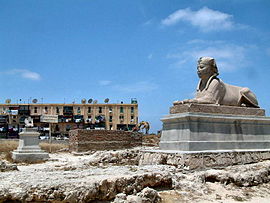
Alexandria, sphinx made of
pink granite
,
Ptolemaic
.
Although Cleomenes was mainly in charge of overseeing Alexandria’s continuous
development, the Heptastadion and the mainland quarters seem to have been
primarily Ptolemaic work. Inheriting the trade of ruined
Tyre
and becoming the centre of the new
commerce between Europe and the
Arabian
and Indian East, the city grew in less
than a generation to be larger than
Carthage
. In a century, Alexandria had become
the largest city in the world and, for some centuries more, was second only to
Rome. It became Egypt’s main Greek city, with
Greek people
from diverse backgrounds.
Alexandria was not only a centre of
Hellenism
, but was also home to the largest
Jewish community in the world. The
Septuagint
, a Greek translation of the
Hebrew Bible
, was produced there. The early
Ptolemies kept it in order and fostered the development of its museum into the
leading Hellenistic center of learning (Library
of Alexandria), but were careful to maintain the distinction of its
population’s three largest ethnicities: Greek, Jewish, and
Egyptian
. From this division arose much of the
later turbulence, which began to manifest itself under
Ptolemy Philopater
who reigned from 221–204 BC.
The reign of
Ptolemy VIII Physcon
from 144–116 BC was marked
by purges and civil warfare.
The city passed formally under Roman jurisdiction in 80 BC, according to the
will of
Ptolemy Alexander
, but only after it had been
under Roman influence for more than a hundred years. It was captured by
Julius Caesar
in 47 BC during a Roman
intervention in the domestic civil war between king
Ptolemy XIII
and his advisers, and the fabled
queen
Cleopatra VII
. It was finally captured by
Octavian
, future
emperor
Augustus on 1 August 30 BC, with the
name of the month later being changed to August to commemorate his
victory.
In AD 115, large parts of Alexandria were destroyed during the
Kitos War
, which gave
Hadrian
and his architect,
Decriannus
, an opportunity to rebuild it. In
215, the
emperor
Caracalla
visited the city and, because of some
insulting satires
that the inhabitants had directed at
him, abruptly commanded his troops to
put to death
all youths capable of bearing
arms. On 21 July 365, Alexandria was devastated by a
tsunami
(365
Crete earthquake), an event still annually commemorated 17 hundred
years later as a “day of horror.” In the late 4th century, persecution of
pagans
by newly Christian Romans had reached
new levels of intensity. In 391, the Patriarch
Theophilus
destroyed all pagan temples in
Alexandria under orders from Emperor
Theodosius I
. The
Brucheum
and Jewish quarters were desolate in
the 5th century. On the mainland, life seemed to have centred in the vicinity of
the Serapeum and
Caesareum
, both of which became
Christian churches
. The
Pharos
and Heptastadium quarters,
however, remained populous and were left intact.
In 619, Alexandria
fell
to the
Sassanid Persians
. Although the
Byzantine Emperor
Heraclius
recovered it in 629, in 641 the Arabs
under the general
Amr ibn al-As
captured it during the
Muslim conquest of Egypt
, after a siege that
lasted 14 months.
Marcus Ulpius Nerva Traianus, commonly known as
Trajan (18 September, 53 – 8 August, 117), was a
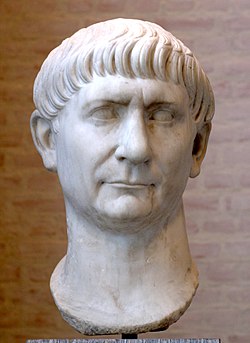 Roman Roman
Emperor who reigned from AD 98 until his death in AD 117. Born
Marcus Ulpius Traianus into a non-patrician
family in the
Hispania Baetica
province (modern day
Spain
), Trajan rose to prominence during the
reign of emperor
Domitian
, serving as a general in the
Roman army
along the
German frontier
, and successfully crushing the
revolt of
Antonius Saturninus
in 89. On September 18, 96,
Domitian was succeeded by
Marcus Cocceius Nerva
, an old and childless
senator who proved to be unpopular with the army. After a brief and tumultuous
year in power, a revolt by members of the
Praetorian Guard
compelled him to adopt the
more popular Trajan as his heir and successor. Nerva died on January 27, 98, and
was succeeded by his adopted son without incident.
As a civilian administrator, Trajan is best known for his
extensive public building program, which reshaped the city of
Rome and left multiple enduring landmarks such as
Trajan’s Forum
,
Trajan’s Market
and
Trajan’s Column
. It was as a military commander
however that Trajan celebrated his greatest
triumphs
. In 101, he launched a
punitive expedition
into the kingdom of
Dacia
against king
Decebalus
, defeating the Dacian army near
Tapae
in 102, and finally conquering Dacia
completely in 106. In 107, Trajan pushed further east and annexed the
Nabataean kingdom
, establishing the province of
Arabia Petraea
. After a period of relative
peace within the Empire, he launched his final campaign in 113 against
Parthia
, advancing as far as the city of
Susa in 116, and expanding the Roman Empire to its greatest extent.
During this campaign Trajan was struck by illness, and late in 117, while
sailing back to Rome, he died of a
stroke
on
August 9
, in the city of
Selinus
. He was
deified
by the Senate and his ashes were laid
to rest under
Trajan’s Column
. He was succeeded by his
adopted son (not having a biological heir)
Publius Aelius Hadrianus
—commonly known as
Hadrian.
As an emperor, Trajan’s reputation has endured – he is one of
the few rulers whose reputation has survived the scrutiny of nineteen centuries
of history. Every new emperor after him was honoured by the Senate with the
prayer felicior Augusto, melior Traiano, meaning “may he be luckier than
Augustus
and better than Trajan”. Among
medieval
Christian theologians, Trajan was
considered a
virtuous pagan
, while the 18th century
historian
Edward Gibbon
popularized the notion of the
Five Good Emperors
, of which Trajan was the
second.
Early life and rise to power
Trajan was born on September 18, 53 in the Roman province of
Hispania Baetica
(in what is now
Andalusia
in modern Spain), a province that was
thoroughly Romanized and called southern Hispania, in the city of
Italica
, where the
Italian
families were paramount. Of
Italian
stock himself, Trajan is frequently but
misleadingly designated the first provincial emperor.
Trajan was the son of
Marcia
and
Marcus Ulpius Traianus
, a prominent
senator
and general from the famous
Ulpia
gens.
Trajan himself was just one of many well-known Ulpii in a line that continued
long after his own death. His elder sister was
Ulpia Marciana
and his niece was
Salonina Matidia
. The
patria
of the Ulpii was
Italica
, in Spanish Baetica, where their
ancestors had settled late in the third century B.C. This indicates that the
Italian origin was paramount, yet it has recently been cogently argued that the
family’s ancestry was local, with Trajan senior actually a Traius who was
adopted into the family of the Ulpii.
As a young man, he rose through the ranks of the
Roman army
, serving in some of the most
contentious parts of the Empire’s frontier. In 76–77, Trajan’s father was
Governor
of
Syria
(Legatus
pro praetore Syriae), where Trajan himself remained as
Tribunus
legionis. Trajan was nominated as
Consul
and brought
Apollodorus of Damascus
with him to
Rome around 91. Along the
Rhine River
, he took part in the Emperor
Domitian
‘s wars while under Domitian’s
successor, Nerva
, who was unpopular with the army and
needed to do something to gain their support. He accomplished this by naming
Trajan as his adoptive son and successor in the summer of 97. According to the
Augustan History
, it was the future Emperor
Hadrian
who brought word to Trajan of his
adoption. When Nerva died on January 27, 98, the highly respected Trajan
succeeded without incident.
His
reign
The new Roman emperor was greeted by the people of Rome with
great enthusiasm, which he justified by governing well and without the
bloodiness that had marked Domitian’s reign. He freed many people who had been
unjustly imprisoned by Domitian and returned a great deal of private property
that Domitian had confiscated; a process begun by Nerva before his death. His
popularity was such that the
Roman Senate
eventually bestowed upon Trajan
the honorific
of optimus, meaning “the
best”.
Dio Cassius
, sometimes known as Dio, reveals
that Trajan drank heartily and was
involved with boys
. “I know, of course, that he
was devoted to boys and to wine, but if he had ever committed or endured any
base or wicked deed as the result of this, he would have incurred censure; as it
was, however, he drank all the wine he wanted, yet remained sober, and in his
relation with boys he harmed no one.” This sensibility was one that influenced
his governing on at least one occasion, leading him to favour the king of Edessa
out of appreciation for his handsome son: “On this occasion, however,
Abgarus
, induced partly by the persuasions of
his son Arbandes, who was handsome and in the pride of youth and therefore in
favour with Trajan, and partly by his fear of the latter’s presence, he met him
on the road, made his apologies and obtained pardon, for he had a powerful
intercessor in the boy.”
Dacian
Wars
It was as a military commander that Trajan is best known to
history, particularly for his conquests in the
Near East
, but initially for the two wars
against Dacia
— the reduction to client kingdom
(101-102), followed by actual incorporation to the Empire of the trans-Danube
border kingdom of Dacia—an area that had troubled Roman thought for over a
decade with the unfavourable (and to some, shameful) peace negotiated by
Domitian
‘s ministers In the first war c.
March–May 101, he launched a vicious attack into the kingdom of
Dacia
with four legions, crossing to the
northern bank of the
Danube River
on a stone bridge he had built,
and defeating the Dacian army near or in a
mountain pass
called
Tapae
(see
Second Battle of Tapae
). Trajan’s troops were
mauled in the encounter, however and he put off further campaigning for the year
to heal troops, reinforce, and regroup.
During the following winter, King
Decebalus
launched a counter-attack across the
Danube
further downstream, but this was
repulsed. Trajan’s army advanced further into Dacian territory and forced King
Decebalus to submit to him a year later, after Trajan took the Dacian
capital/fortress of
Sarmizegethusa
. The Emperor Domitian had
campaigned against
Dacia from 86 to 87
without securing a decisive
outcome, and Decebalus had brazenly flouted the terms of the peace (89 AD) which
had been agreed on conclusion of this campaign.
Trajan now returned to Rome in triumph and was granted the
title Dacicus Maximus. The victory was celebrated by the
Tropaeum Traiani
. Decebalus though, after being
left to his own devices, in 105 undertook an invasion against Roman territory by
attempting to stir up some of the tribes north of the river against her.
Trajan took to the field again and after building with the
design of
Apollodorus of Damascus
his
massive bridge over the Danube
, he conquered
Dacia completely in 106. Sarmizegethusa was destroyed,
Decebalus
committed
suicide
, and his severed head was exhibited in
Rome on the steps leading up to the
Capitol
. Trajan built a new city, “Colonia
Ulpia Traiana Augusta Dacica Sarmizegetusa”, on another site than the previous
Dacian Capital, although bearing the same full name, Sarmizegetusa. He resettled
Dacia with Romans and annexed it as a province of the Roman Empire. Trajan’s
Dacian campaigns benefited the Empire’s finances through the acquisition of
Dacia’s gold mines. The victory is celebrated by
Trajan’s Column
.
Expansion
in the East
At about the same time
Rabbel II Soter
, one of Rome’s client kings,
died. This event might have prompted the annexation of the
Nabataean kingdom
, although the manner and the
formal reasons for the annexation are unclear. Some epigraphic evidence suggests
a military operation, with forces from
Syria
and
Egypt
. What is clear, however, is that by 107,
Roman legions were stationed in the area around
Petra
and
Bostra
, as is shown by a papyrus found in
Egypt. The empire gained what became the province of
Arabia Petraea
(modern southern
Jordan
and north west
Saudi Arabia
).
Period
of peace
The next seven years, Trajan ruled as a civilian emperor, to
the same acclaim as before. It was during this time that he corresponded with
Pliny the Younger
on the subject of how to deal
with the
Christians
of
Pontus
, telling Pliny to leave them alone
unless they were openly practicing the religion. He built several new buildings,
monuments and roads in
Italia
and his native
Hispania
. His magnificent complex in Rome
raised to commemorate his victories in
Dacia
(and largely financed from that
campaign’s loot)—consisting of a
forum
,
Trajan’s Column
, and Trajan’s Market still
stands in Rome today. He was also
a prolific builder of triumphal arches
, many of
which survive, and rebuilder of roads (Via
Traiana and
Via Traiana Nova
).
One notable act of Trajan was the hosting of a three-month
gladiatorial
festival in the great
Colosseum
in Rome (the precise date of this
festival is unknown). Combining chariot racing, beast fights and close-quarters
gladiatorial bloodshed, this gory spectacle reputedly left 11,000 dead (mostly
slaves and criminals, not to mention the thousands of ferocious beasts killed
alongside them) and attracted a total of five million spectators over the course
of the festival.
Another important act was his formalisation of the
Alimenta, a welfare program that helped orphans and poor children throughout
Italy. It provided general funds, as well as food and subsidized education. The
program was supported initially by funds from the Dacian War, and then later by
a combination of estate taxes and philanthropy.[13].
Although the system is well documented in literary sources and contemporary
epigraphy, its precise aims are controversial and have generated considerable
dispute between modern scholars: usually, it’s assumed that the programme
intended to bolster citzen numbers in Italy. However, the fact that it was
subsidized by means of interest payments on loans made by landowners restricted
it to a small percentage of potential welfare recipients (Paul
Veyne has assumed that, in the city of
Veleia
, only one child out of ten was an actual
beneficiary) – therefore, the idea, advanced by
Moses I. Finley
, that the whole scheme was at
most a form of random charity, a mere imperial benevolence[14].
Maximum
extent of the Empire

The extent of the Roman Empire under Trajan (117)
In 113, he embarked on his last campaign, provoked by
Parthia
‘s decision to put an unacceptable king
on the throne of Armenia
, a kingdom over which the two great
empires had shared
hegemony
since the time of
Nero some fifty years earlier. Some modern historians also attribute
Trajan’s decision to wage war on Parthia to economic motives: to control, after
the annexation of Arabia, Mesopotamia and the coast of the Persian Gulf, and
with it the sole remaining receiving-end of the Indian trade outside Roman
control – an attribution of motive other historians find absurd, as seeing a
commercial motive in a campaign triggered by the lure of territorial annexation
and prestige – by the way, the only motive for Trajan’s actions ascribed by Dio
Cassius in his description of the events. Other modern historians, however,
think that Trajan’s original aim was quite modest: to assure a more defensible
Eastern frontier for the Roman Empire, crossing across Northern Mesopotamia
along the course of the river
Khabur
in order to offer cover to a Roman
Armenia.
Trajan marched first on Armenia, deposed the
Parthian-appointed king (who was afterwards murdered while kept in the custody
of Roman troops in an unclear incident) and annexed it to the Roman Empire as a
province, receiving in passing the acknowledgement of Roman hegemony by various
tribes in the Caucasus and on the Eastern coast of the Black Sea – a process
that kept him busy until the end of 114].
The cronology of subsequent events is uncertain, but it’s generally believed
that early in 115 Trajan turned south into the core Parthian hegemony, taking
the Northern Mesopotamian cities of
Nisibis
and
Batnae
and organizing a province of
Mesopotamia
in the beginning of 116, when coins
were issued announcing that Armenia and Mesopotamia had been put under the
authority of the Roman people.
In early 116, however, Trajan began to toy with the conquest
of the whole of Mesopotamia, an overambitious goal that eventually backfired on
the results of his entire campaign: One Roman division crossed the
Tigris
into
Adiabene
, sweeping South and capturing
Adenystrae
; a second followed the river South,
capturing Babylon
; while Trajan himself sailed down the
Euphrates
, then dragged his fleet overland into
the Tigris, capturing
Seleucia
and finally the Parthian capital of
Ctesiphon
. He continued southward to the
Persian Gulf
, receiving the submission of
Athambelus, the ruler of
Charax
, whence he declared Babylon a new
province of the Empire, sent the Senate a laurelled letter declaring the war to
be at a close and lamented that he was too old to follow in the steps of
Alexander the Great
and reach the distant
India
itself. A province of
Assyria
was also proclaimed, apparently
covering the territory of Adiabene, as well as some measures seem to have been
considered about the fiscal administration of the Indian trade.
However, as Trajan left the Persian Gulf for Babylon – where
he intended to offer sacrifice to Alexander in the house where he had died in
323 B.C.- a sudden outburst of Parthian resistance, led by a nephew of the
Parthian king, Sanatrukes, imperilled Roman positions in Mesopotamia and
Armenia, something Trajan sought to deal with by forsaking direct Roman rule in
Parthia proper, at least partially: later in 116, after defeating a Parthian
army in a battle where Sanatrukes was killed and re-taking Seleucia, he formally
deposed the Parthian king
Osroes I
and put his own puppet ruler
Parthamaspates
on the throne. That done, he
retreated North in order to retain what he could of the new provinces of Armenia
and Mesopotamia.
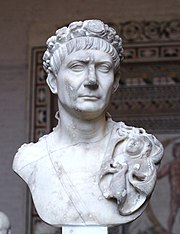
Bust of Trajan,
Glyptothek
,
Munich
.
It was at this point that Trajan’s health started to fail
him. The fortress city of
Hatra
, on the
Tigris
in his rear, continued to hold out
against repeated Roman assaults. He was personally present at the
siege
and it is possible that he suffered a
heat stroke while in the blazing heat. Shortly afterwards, the
Jews inside the Eastern Roman Empire rose up in rebellion once more,
as did the people of Mesopotamia. Trajan was forced to withdraw his army in
order to put down the revolts. Trajan saw it as simply a temporary setback, but
he was destined never to command an army in the field again, turning his Eastern
armies over to the high ranking legate and governor of Judaea,
Lusius Quietus
, who in early 116 had been in
charge of the Roman division who had recovered Nisibis and
Edessa
from the rebels; Quietus was promised
for this a consulate in the following year – when he was actually put to death
by Hadrian
, who had no use for a man so committed
to Trajan’s aggressive policies.
Early in 117, Trajan grew ill and set out to sail back to
Italy. His health declined throughout the spring and summer of 117, something
publicy acknowledged by the fact that a bronze bust displayed at the time in the
public baths of
Ancyra
showed him clearly aged and edemaciated.
By the time he had reached Selinus in
Cilicia
which was afterwards called
Trajanopolis, he suddenly died from
edema
on August 9. Some say that he had adopted
Hadrian
as his successor, but others that it
was his wife
Pompeia Plotina
who hired someone to
impersonate him after he had died.
Hadrian
, upon becoming ruler, recognized the
abandonment of Mesopotamia and restored Armenia – as well as
Osroene
– to the Parthian hegemony under Roman
suzerainty – a telling sign the Roman Empire lacked the means for pursuing
Trajan’s overambitious goals. However, all the other territories conquered by
Trajan were retained. Trajan’s ashes were laid to rest underneath Trajan’s
column, the monument commemorating his success.
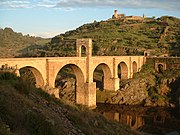
The
Alcántara Bridge
, widely hailed as
a masterpiece of
Roman engineering
.
Building
activities
Trajan was a prolific builder in Rome and the provinces, and
many of his buildings were erected by the gifted architect
Apollodorus of Damascus
. Notable structures
include
Trajan’s Column
,
Trajan’s Forum
,
Trajan’s Bridge
,
Alcántara Bridge
, and possibly the
Alconétar Bridge
. In order to build his forum
and the adjacent brick market that also held his name Trajan had vast areas of
the surrounding hillsides leveled.
Trajan’s
legacy
Unlike many lauded rulers in history, Trajan’s reputation has
survived undiminished for nearly nineteen centuries.
Ancient sources on Trajan’s personality and accomplishments
are unanimously positive. Pliny the younger, for example, celebrates Trajan in
his panegyric as a wise and just emperor and a moral man.
Dio Cassius
admits Trajan had vices like heavy
drinking and sexual involvement with boys, but added that he always remained
dignified and fair. The
Christianisation
of Rome resulted in further
embellishment of his legend: it was commonly said in
medieval
times that
Pope Gregory I
, through divine intercession,
resurrected Trajan from the dead and baptized him into the Christian faith. An
account of this features in the
Golden Legend
.
Theologians, such as
Thomas Aquinas
, discussed Trajan as an example
of a virtuous pagan. In
the Divine Comedy
,
Dante
, following this legend, sees the spirit
of Trajan in the Heaven of
Jupiter
with other historical and mythological
persons noted for their justice.
He also features in
Piers Plowman
. An episode, referred to as
the
justice of Trajan
was reflected in several art
works.
In the 18th Century King
Charles III of Spain
comminsioned
Anton Raphael Mengs
to paint The Triumph of
Trajan on the ceiling of the banqueting-hall of the
Royal Palace of Madrid
– considered among the
best work of this artist.
“Traian” is used as a male first name in present-day
Romania
– among others, that of the country’s
incumbent president,
Traian Băsescu
.
The sestertius, or sesterce, (pl. sestertii) was an
ancient Roman
coin. During the
Roman Republic
it was a small,
silver
coin issued only on rare occasions.
During the
Roman Empire
it was a large
brass
coin.

Helmed Roma head right, IIS behind
Dioscuri
riding right, ROMA in linear frame
below. RSC4, C44/7, BMC13.
The name sestertius (originally semis-tertius) means “2 ½”, the
coin’s original value in
asses
, and is a combination of semis
“half” and tertius “third”, that is, “the third half” (0 ½ being the
first half and 1 ½ the second half) or “half the third” (two units
plus half the third unit, or halfway between the second unit and
the third). Parallel constructions exist in
Danish
with halvanden (1 ½),
halvtredje (2 ½) and halvfjerde (3 ½). The form sesterce,
derived from
French
, was once used in preference to the
Latin form, but is now considered old-fashioned.
It is abbreviated as (originally IIS).

Example of a detailed portrait of
Hadrian
117 to 138
History
The sestertius was introduced c. 211 BC as a small
silver
coin valued at one-quarter of a
denarius
(and thus one hundredth of an
aureus
). A silver denarius was supposed to
weigh about 4.5 grams, valued at ten grams, with the silver sestertius valued at
two and one-half grams. In practice, the coins were usually underweight.
When the denarius was retariffed to sixteen asses (due to the gradual
reduction in the size of bronze denominations), the sestertius was accordingly
revalued to four asses, still equal to one quarter of a denarius. It was
produced sporadically, far less often than the denarius, through 44 BC.

Hostilian
under
Trajan Decius
250 AD
In or about 23 BC, with the coinage reform of
Augustus
, the denomination of sestertius was
introduced as the large brass denomination. Augustus tariffed the value of the
sestertius as 1/100 Aureus
. The sestertius was produced as the
largest brass
denomination until the late 3rd century
AD. Most were struck in the mint of
Rome but from AD 64 during the reign of
Nero (AD 54–68) and
Vespasian
(AD 69–79), the mint of
Lyon (Lugdunum), supplemented production. Lyon sestertii can
be recognised by a small globe, or legend stop), beneath the bust.[citation
needed]
The brass sestertius typically weighs in the region of 25 to 28 grammes, is
around 32–34 mm in diameter and about 4 mm thick. The distinction between
bronze
and brass was important to the Romans.
Their name for brass
was
orichalcum
, a word sometimes also spelled
aurichalcum (echoing the word for a gold coin, aureus), meaning
‘gold-copper’, because of its shiny, gold-like appearance when the coins were
newly struck (see, for example
Pliny the Elder
in his Natural History
Book 34.4).
Orichalcum
was considered, by weight, to be
worth about double that of bronze. This is why the half-sestertius, the
dupondius
, was around the same size and weight
as the bronze as, but was worth two asses.
Sestertii continued to be struck until the late 3rd century, although there
was a marked deterioration in the quality of the metal used and the striking
even though portraiture remained strong. Later emperors increasingly relied on
melting down older sestertii, a process which led to the zinc component being
gradually lost as it burned off in the high temperatures needed to melt copper (Zinc
melts at 419 °C, Copper
at 1085 °C). The shortfall was made up
with bronze and even lead. Later sestertii tend to be darker in appearance as a
result and are made from more crudely prepared blanks (see the
Hostilian
coin on this page).
The gradual impact of
inflation
caused by
debasement
of the silver currency meant that
the purchasing power of the sestertius and smaller denominations like the
dupondius and as was steadily reduced. In the 1st century AD, everyday small
change was dominated by the dupondius and as, but in the 2nd century, as
inflation bit, the sestertius became the dominant small change. In the 3rd
century silver coinage contained less and less silver, and more and more copper
or bronze. By the 260s and 270s the main unit was the double-denarius, the
antoninianus
, but by then these small coins
were almost all bronze. Although these coins were theoretically worth eight
sestertii, the average sestertius was worth far more in plain terms of the metal
they contained.
Some of the last sestertii were struck by
Aurelian
(270–275 AD). During the end of its
issue, when sestertii were reduced in size and quality, the
double sestertius
was issued first by
Trajan Decius
(249–251 AD) and later in large
quantity by the ruler of a breakaway regime in the West called
Postumus
(259–268 AD), who often used worn old
sestertii to
overstrike
his image and legends on. The double
sestertius was distinguished from the sestertius by the
radiate crown
worn by the emperor, a device
used to distinguish the dupondius from the as and the antoninianus from the
denarius.
Eventually, the inevitable happened. Many sestertii were withdrawn by the
state and by forgers, to melt down to make the debased antoninianus, which made
inflation worse. In the coinage reforms of the 4th century, the sestertius
played no part and passed into history.
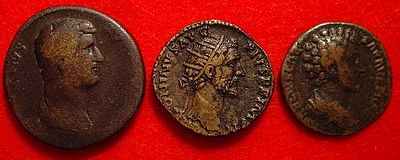
Sestertius of
Hadrian
, dupondius of
Antoninus Pius
, and as of
Marcus Aurelius
As a unit of account
The sestertius was also used as a standard unit of account, represented on
inscriptions with the monogram HS. Large values were recorded in terms of
sestertium milia, thousands of sestertii, with the milia often
omitted and implied. The hyper-wealthy general and politician of the late Roman
Republic,
Crassus
(who fought in the war to defeat
Spartacus
), was said by Pliny the Elder to have
had ‘estates worth 200 million sesterces’.
A loaf of bread cost roughly half a sestertius, and a
sextarius
(~0.5 liter) of
wine anywhere from less than half to more than 1 sestertius. One
modius
(6.67 kg) of
wheat
in 79 AD
Pompeii
cost 7 sestertii, of
rye
3 sestertii, a bucket 2 sestertii, a tunic 15 sestertii, a donkey 500 sestertii.
Records from Pompeii
show a
slave
being sold at auction for 6,252
sestertii. A writing tablet from
Londinium
(Roman
London
), dated to c. 75–125 AD, records the
sale of a Gallic
slave girl called Fortunata for 600
denarii, equal to 2,400 sestertii, to a man called Vegetus. It is difficult to
make any comparisons with modern coinage or prices, but for most of the 1st
century AD the ordinary
legionary
was paid 900 sestertii per annum,
rising to 1,200 under
Domitian
(81-96 AD), the equivalent of 3.3
sestertii per day. Half of this was deducted for living costs, leaving the
soldier (if he was lucky enough actually to get paid) with about 1.65 sestertii
per day.
Perhaps a more useful comparison is a modern salary: in 2010 a private
soldier in the US Army (grade E-2) earned about $20,000 a year.
Numismatic value

A sestertius of
Nero
, struck at
Rome
in 64 AD. The reverse depicts
the emperor on horseback with a companion. The legend reads DECVRSIO,
‘a military exercise’. Diameter 35mm
Sestertii are highly valued by
numismatists
, since their large size gave
caelatores (engravers) a large area in which to produce detailed portraits
and reverse types. The most celebrated are those produced for
Nero (54-68 AD) between the years 64 and 68 AD, created by some of
the most accomplished coin engravers in history. The brutally realistic
portraits of this emperor, and the elegant reverse designs, greatly impressed
and influenced the artists of the
Renaissance
. The series issued by
Hadrian
(117-138 AD), recording his travels
around the Roman Empire, brilliantly depicts the Empire at its height, and
included the first representation on a coin of the figure of
Britannia
; it was revived by
Charles II
, and was a feature of
United Kingdom
coinage until the
2008 redesign
.
Very high quality examples can sell for over a million
dollars
at auction as of 2008, but the coins
were produced in such colossal abundance that millions survive.
|










 Roman
Roman










